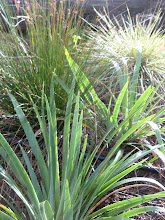
Remember the Lily Lady? Well, both gallon-containers of L. rubescens are sprouting! (The bunny ears above are two of many seedling.) Nothing's happening with the L. washintonianum spp. purpuratum (yet). Both gallon-containers of L. pardilinum have also sprouted. The Clintonia andrewsiana seed from the forest (mentioned in the Lily Lady post) sprouted a couple of weeks ago. Exciting!
I'm glad I filled the pots to the brim last fall (not worrying about a reservoir), as the Lily Lady suggested, because the soil has settled down almost an inch in the pots and they wouldn't be getting enough sunlight if they were much lower. The pots were outside in partial shade (behind the fountain) all winter long, except for the Clintonia (pictured below), which was in a flat in our forest (which has now been moved by the fountain) . I never watered the seeds. There was no pretreatment (except for the Clintonia, whose seeds were washed and soaked in warm water for 24 hours before sowing). There was no greenhouse or growlight involved. I used a seed starting mix.

Now if I can just keep them all alive--which really means protecting them from slugs (how do I do that?), not fussing over them too much, and letting them go dormant, and transplanting them at the right times-- for four or so years, I may have some flowering plants. Advice is always welcome.

8 comments:
Congratulations! L. pardalinum came up here a week or two ago. Now that you've germinated them, the trick is to nurse them through their first dormancy. Keep them going as long as you can (I don't think you can water them too much when they are in active growth), and then, of course, you have to keep them dry once they go dormant. But not too hot and dry, or the tiny little bulbs will dessicate. Sadly, I don't know precisely what not too hot and dry means: and I appear to have fried some Fritillaria recurva last summer. This year I am going to keep the young bulbs in the basement instead of the garage, and hope that helps.
You will have to put them somewhere the slugs can't get them, or else go out and kill slugs every night with a flashlight.
How wonderful but it sounds like a daunting task to keep them alive in a pot through that dormancy as mmw mentions. Can they not be left outside with the pot buried in the soil? We have had good luck with the slug repelling qualities of copper. A collar of the metal around inside edge of the pot might work. We ordered very fine copper screening online to line the shelves of the orchids while they summer outdoors and it worked. Pricey, but one time purchase.
Frances at Faire Garden
i kill slugs with beer.
Lisa, beer is for killing brain cells, not gastropods.
Unless your slug problem is truly severe, I doubt you'll have a problem with potted plants.
"L. washintonianum spp. purpuratum", eh?! Fascinating! If you get those to work, would you consider selling me a bulb? I would gladly buy!
So far the slugs haven't bothered them, but I imagine it would only take one to decimate a pot, so I'll keep an eye out.
Chuck, the L. washingtonium ssp. purpuratum appeared a few days after I noticed the other lilies. So in a few years if, say, more than seven (?) miraculously survive to good bulb size, I'll gladly give, sell, or, preferably, trade you one for something from your garden.
(Also, if you're interested, you can find seed at http://www.lilyseed.com/index.html)
Holy crap they've got a lot of lily seeds for sale.
p.s. The slugs which devour every bit of lupine in my garden never found their way to my lily seedlings. Best to keep them away, obviously but I doubt heroic measures are called for.
Post a Comment